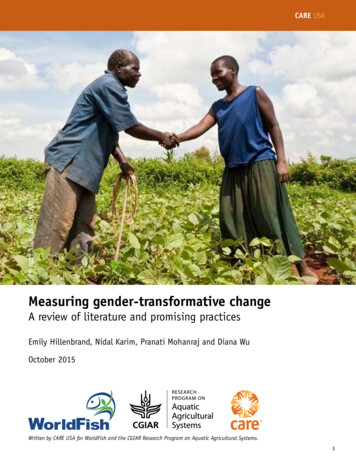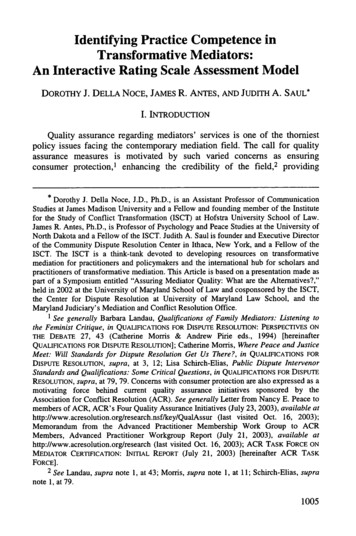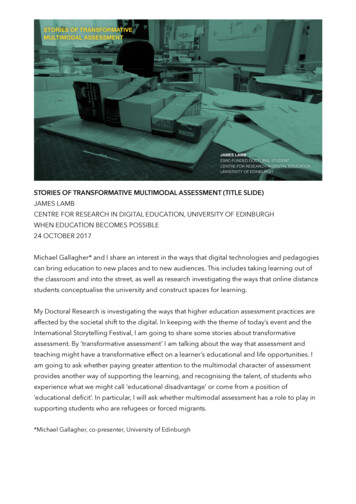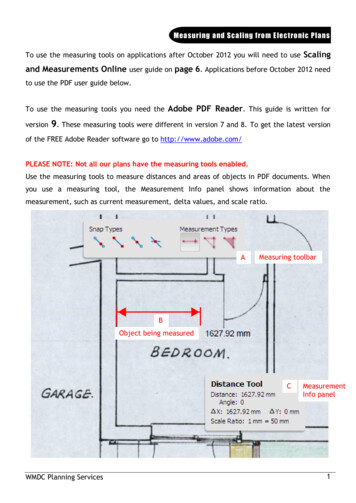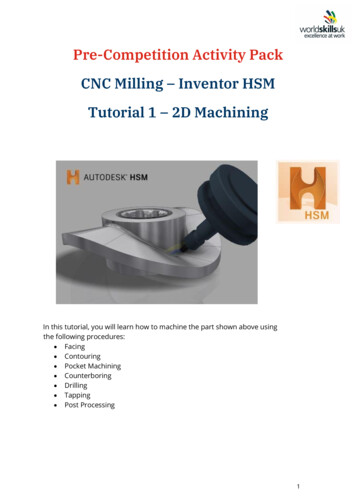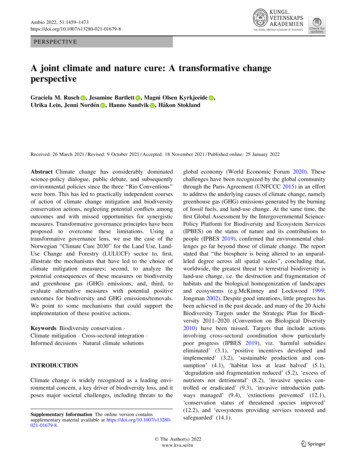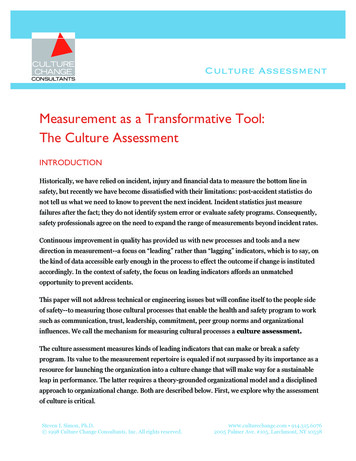
Transcription
Culture AssessmentMeasurement as a Transformative Tool:The Culture AssessmentINTRODUCTIONHistorically, we have relied on incident, injury and financial data to measure the bottom line insafety, but recently we have become dissatisfied with their limitations: post-accident statistics donot tell us what we need to know to prevent the next incident. Incident statistics just measurefailures after the fact; they do not identify system error or evaluate safety programs. Consequently,safety professionals agree on the need to expand the range of measurements beyond incident rates.Continuous improvement in quality has provided us with new processes and tools and a newdirection in measurement--a focus on “leading” rather than “lagging” indicators, which is to say, onthe kind of data accessible early enough in the process to effect the outcome if change is institutedaccordingly. In the context of safety, the focus on leading indicators affords an unmatchedopportunity to prevent accidents.This paper will not address technical or engineering issues but will confine itself to the people sideof safety--to measuring those cultural processes that enable the health and safety program to worksuch as communication, trust, leadership, commitment, peer group norms and organizationalinfluences. We call the mechanism for measuring cultural processes a culture assessment.The culture assessment measures kinds of leading indicators that can make or break a safetyprogram. Its value to the measurement repertoire is equaled if not surpassed by its importance as aresource for launching the organization into a culture change that will make way for a sustainableleap in performance. The latter requires a theory-grounded organizational model and a disciplinedapproach to organizational change. Both are described below. First, we explore why the assessmentof culture is critical.Steven I. Simon, Ph.D. 1998 Culture Change Consultants, Inc. All rights reserved.www.culturechange.com 914.315.60762005 Palmer Ave. #105, Larchmont, NY 10538
culturechange.comWHY MEASURE CULTURE?Just as the surgeon should order diagnostic x-rays before operating, so the organization shouldcarefully assess its culture before initiating change. Without advance inquiry into the root beliefs,norms and assumptions that drive people’s behavior, even the best programmatic efforts may bemisdirected. To insure attention to the sources rather than the symptoms of safety problems, thatinquiry should yield: Description of the organization’s prevailing culture Evaluation of cultural readiness for change Identification of affected parties Determination of appropriate areas for interventionMeasuring the safety culture identifies leading indicators of the safety process, which serve asongoing metrics for preventive factors that affect end results, not simply after-the-fact accidentfrequency statistics. These leading indicators comprise a context for a comprehensive view of thecurrent safety process.Moreover, a culture assessment creates an ongoing cultural data base. Whereas, ordinarily only a fewemployees voice strong opinions and management has no way of knowing how widespread orimportant the raised issues are, the culture assessment process institutionalizes frequentinvestigation of both surface and in-depth issues to present a global safety culture picture. It posessuch questions as, “Does my boss care about me or just the numbers?” “How safe is safe enough?”“Will I be backed up if I stop an unsafe job or will I be labeled a trouble maker?” The answers revealways people relate to each other. Without data, decisions in safety are made on feelings andopinions. Only with data--clear, dependable and fact-based--can change agents analyze the need forchange, define its specific direction, and make the requisite commitment to it.Concentrating on safety as a single, strategic, operational area concurrently generates insight intokey issues that impact other performance areas such as productivity, quality, cost control and evencustomer service. A safety culture assessment is a lens through which to view the organization as awhole. Yet, unlike unwieldy organization-wide studies, a safety culture assessment is focused andcorrespondingly cost-effective in terms of both time and money.In sum, a culture assessment can be a catalyst for transformational change. The holding up of amirror of the organization’s strengths and deficiencies for its leaders is often experienced as anemotional event that triggers a change impulse in companies where previous attempts to overcome 1998 Culture Change Consultants, Inc. All rights reserved.2
culturechange.cominertia have failed. It makes the case for change by sending a personal, meaningful, powerfulmessage quite distinct from the customary “Get your numbers down!”A TRANSFORMATIVE CULTURE ASSESSMENT IS NOT JUSTA PERCEPTION SURVEYThe culture assessment process that becomes a catalyst for organizational transformation is not to beconfused with the popular, off-the-shelf products referred to as “culture perception surveys.” Itstransformative potential derives from five features of which the perception survey is only one part(see 3, below).The Transformative Culture Assessment Is:1. A change intervention process. A transformative culture assessment catalyzes change byproviding leaders with data for developing and implementing strategic initiatives that mobilizepeople in a new direction.2. Based on qualitative data. Perception surveys are not enough. A transformative assessmentrequires the insights, instincts and skills of a trained organizational clinician.3. Based on quantitative data. An effective assessment uses a variety of number-based tools tocapture behavior and perception, such as observations and surveys. The quantitative data is usefulnot only for understanding the organizational culture in its own right, but also for comparing theorganization normatively with others. It is particularly difficult to drive change without numbersbecause the language of management is quantitative. Therefore, the transformative assessment mustspeak that language, too.4. A management and leadership tool. Only leadership can change and shape a new culture.The transformative culture assessment must be sponsored by the leadership group (comprised offormal and informal leaders, both union and management) for the sake of the whole organization,not just the safety department. The assessment is a tool to gather information that leaders can use tospearhead the safety culture transformation.5. Face-to-face communication. The findings of a culture assessment have optimumtransformative power when presented live to the leadership group and the rest of the organization,in keeping with the strong emotional component of the motivation for creating and sustainingchange. In-person sharing of the results of the assessment maximizes opportunities for honest selfexamination and informed commitment to change. 1998 Culture Change Consultants, Inc. All rights reserved.3
culturechange.comUSE OF A MODEL WHEN ASSESSING A CULTUREThe transformative culture assessment is best used in conjunction with a research-based modelgrounded in theory for three reasons. First, the model ensures a comprehensive approach toevaluating the whole organization. Second, it provides a shared framework for interpreting data anddeveloping recommendations. Only by means of a shared vocabulary can vision be communicatedand translated into action throughout the organization. Finally, and crucially, a scientific modelenhances the credibility of the findings and helps to elicit the support of “show-me” skeptics.The model used throughout this paper has been applied for more than ten years in over one hundredculture assessments with Fortune 500 companies in both manufacturing and service areas. Theseinclude chemical plants, hospitals, research labs, turbine manufacturing operations, auto assemblyplants, engineering concerns and utility plants. Its effectiveness in generating cultural interventionsto improve safety performance is documented in the endnotes of this paper.1The model proposes an original interdisciplinary approach to culture assessment. It incorporatestheories from organizational development, organizational psychology and organizational culture,while applying the technologies of change management and employee involvement to assist leadersin transforming their safety cultures. The model is called the Simon Open System (S.O.S.) CultureChange Model .The S.O.S. Culture Change Model is based on a framework (Figure 1) that views safetyperformance as an integral part of organizational work, technology, systems, people and culture. TheS.O.S. Model embraces a whole systems perspective rather than focusing on individual, fix-itstrategies because without a comprehensive model, one cannot be assured of capturing all of theelements that might be impacting safety performance.The S.O.S Model is designed to evaluate the safety process by dealing with a wide range of leadingindicators to safety performance, inclusive of both the structural and technological factors that gointo creating a safe environment, and the cultural influences that shape safety norms or behaviors. Itdevelops a profile of the barriers and supports within the organization that affect its ability tomanage safety efforts in order to provide a road map to design strategy for performanceimprovement. 1998 Culture Change Consultants, Inc. All rights reserved.4
culturechange.comFigure 1. S.O.S. Culture Change Model : A Framework for Diagnosis and Action Planning.In this culture assessment model, four areas of influence that determine the quality of safetyperformance in organizations are highlighted: (1) External pressures such as the marketplaceand government regulations influence companies to set goals and initiate improvement strategies;(2) The quality of strategic planning and resources applied to achieving those goals influencesthe process and outcomes; (3) Organizational systems must be aligned to support changeinitiatives; and, (4) The culture must support implementation.The external environment that influences safety performance includes government regulations,customers, stockholders, workers’ compensation costs, and the market place. Pressures from any ofthese groups influence the company's safety strategy and objectives. For example, a rise in workers’compensation costs can result in a company objective to reduce accidents. A strategy is then formedto achieve these objectives. For this reason, strategy is viewed as “input” to the organization. 1998 Culture Change Consultants, Inc. All rights reserved.5
culturechange.comThe organizational and cultural systems of a company comprise the transformational process whichdetermines the quality of “outputs” or safety performance. Ideally, the organizational and culturalsystems of the organization are in line (aligned) with the strategic objectives. The two-directionarrows between these symbolize a reciprocal influence. Organizational systems influence culture,and culture influences organizational systems, etc. It should be noted that norms and assumptionsare depicted as a shadow behind culture because although an integral part of the safety process,these are invisible.Finally, the environment evaluates performance (output) and gives positive or negative feedback tothe organization. For example, increased accidents could result in higher insurance costs,shareholder discontent, government penalties or community resentments. This feedback will in turnaffect organizational strategy and the cycle begins again.In particular, the S.O.S. Culture Change Model examines six organizational systems and sixcultural systems, each a leading indicator to improving safety performance. Tables 1 and 2 breakdown the components and define their meaning.Table 1. Itemization and Definition of Organizational InfluencesORGANIZATIONAL INFLUENCESDEFINITIONTechnologyHow the work is done.Program StructureTraining, policy, procedure, etc.RewardsPromotions, compensation, awards.MeasurementsLeading as well as lagging indicators of safetyperformance.Social ProcessesTrust, communication, caring, relationships.EnvironmentExternal business pressures to improve safetyperformance such as government regulations,customers, stockholders, workers’compensation costs, and the market place. 1998 Culture Change Consultants, Inc. All rights reserved.6
culturechange.comTable 2. Itemization and Definition of Cultural InfluencesCULTURAL INFLUENCESDEFINITIONLeadershipEstablishes vision and sets example for the newsafety culture in a way that leads the organizationtowards zero injuries.SymbolsPhysical or visual reminders of important safetyvalues.ValuesSpoken principles such as “people are moreimportant than numbers” that guide the decisions ofworkers and managers.HeroesOrganizational members that role model the values.RitualsRegular celebrations, ceremonies or activities thatreinforce the importance of safety.Norms and AssumptionsNorms are the group’s expectations for safetybehavior. Assumptions are the beliefs about what issafe or unsafe and why it is commonly accepted toperform a job in a safe or unsafe manner.Open systems theory means that there are many “right ways” to achieve a desired outcome. Use of anopen systems model to produce a safety culture assessment means that action plans will be tailoredspecifically to each facility’s needs.THE S.O.S. SAFETY CULTURE PERCEPTION SURVEY The perception survey is a valuable tool for determining where an organization is at present in that itmeasures norms and assumptions as well as management systems. It provides quantitativemeasurements for such “soft” issues as belief in management commitment to safety, trust, caringand communication. There are numerous studies in the research literature that show that accidentfrequency rates and workers’ compensation costs correlate with employee ratings of the safetyculture as measured by perception surveys.2Like the broader culture assessment process, perception surveys also are based upon either animplicit or explicit model within whose framework perceptions are interpreted, and the model is inturn either research and theory-grounded or not. Certainly, the greater the research and theory base, 1998 Culture Change Consultants, Inc. All rights reserved.7
culturechange.comthe greater the scientific underpinning of the instrument, and the more likely it has the potential togenerate meaningful organizational change.The perception survey derived from the S.O.S. Culture Change Model has 51 statements that arerated on a Likert-type 1-5 scale. The 51 statements are indexed according to twelve subscales(defined in Tables 1 and 2). The twelve organizational and cultural dimensions that are measured areleadership, rituals, values, norms, rewards, measurements, structure, social processes, technology,environment, heroes and symbols. The survey has been administered to more than 100,000employees at more than 100 facilities. The use of the survey as a part of the overall cultureassessment process is illustrated in the case history that will follow.CONDUCTING THE CULTURE ASSESSMENT: 4 STEPSIn using the S.O.S. Culture Change Model , we recommend a 4-step process to analyze the currentorganization and plan future strategies.Step 1: Gather and Analyze the DataStep 2. Chart the Data onto the Culture Assessment ModelStep 3. Deliver Face-to-Face FeedbackStep 4: Initiate Action PlanningTo illustrate the four steps of the culture assessment process, we shall apply them in the context of acomposite case study of an oil refinery. The assessment takes place at the Sandblast refinery of theGood Oil Company. The Good Oil Co. operates refineries around the world. The Sandblast refineryhas nearly one thousand employees and is structured around three major departments: Process,Mechanical and Technical/Administrative support. Process and Mechanical departments haveapproximately 400 employees each; Technical and Administration, 200.Step 1. Gather and Analyze the DataData is gathered during a culture assessment in three chief ways: Observations Interviews Perception Surveys 1998 Culture Change Consultants, Inc. All rights reserved.8
culturechange.comIn all three data-gathering modes, the assessment should be conducted in a highly inclusive andparticipative manner. It is, of course, critical to enlist members from all levels and all parts of theorganization in order to develop more accurate information, and to obtain buy-in needed toimplement the necessary changes. Let us look at each method of data-gathering in turn.ObservationsObservations are conducted in as many different work settings as possible. Observations focus on themundane aspects of a safety culture: What safety reports are people asked to complete? How dopeople talk to each other about safety concerns? From management, who is present or absent atsafety meetings?Observations reveal data about both the tangible and behavioral features of a culture. The firstcategory includes artifacts, like company safety policies, accident logs, safety bulletin boards; rituals,such as safety themes, stories and myths; and, people, like department heads, division presidents,head of the union safety committee. The second category embodies behavioral norms in action, theprescribed and proscribed safety behavior at work, in safety meetings and management discussions,such as sleeping at meetings, glossing over accident investigations in management sessions, andleaving the chock in the truck when parking. It is important to note that the same or similarbehaviors may mean very different things and have different consequences, depending on what theymean to people in a particular culture. Reporting a near miss to a boss in one plant may earn theemployee a citation for excellence and a 500 bonus at year end; while in another plant, theemployee may be handed a final paycheck.During the initial culture assessment at the Sandblast refinery, we observed managementstaff meetings. At one meeting, an hour was devoted to safety.The head of the Mechanical Dept. decided that trying to plan for safety was a waste of timebecause the site had other problems that needed to be addressed first; he informed the groupthat he would be against any new focus on safety, that they were “safe enough.” He said themain problem at the site was “Capital-L Leadership” which he defined as the use of disciplineand enforcement.The head of the Process Dept. sat quietly and announced he was in favor of any good effortsin the safety area because it is always important to keep fresh, new programs coming out insafety to keep people alert. 1998 Culture Change Consultants, Inc. All rights reserved.9
culturechange.comThe head of the Technical/Administrative Dept. said his people never had any accidents, sowhatever the others decided would be fine, and he needed to leave to attend to some work. Hegot up and left.The Plant Manager affirmed that safety was important, and that he was going to implementa new safety program. However, he held back from directing the head of the MechanicalDept. to endorse the new program and give it a fair shake.InterviewsThe interview is a general data gathering method involving face-to-face inquiry of members in theorganization. It can be structured or unstructured, individual and group. The interview willsupplement data gathered by observation and will often uncover the meaning behind the artifact; itcan determine, for example, whether the safety statistics posted on the bulletin board are perceivedpositively as an effective communications device or cynically as mere compliance with regulation.The interview identifies the root structure of underlying values and beliefs of the safety culture. Itanswers key questions: Are there many or few shared beliefs? How widely or narrowly are valuesheld? How strong are safety values compared with other company values like productivity, costeffectiveness and quality?Perception SurveysThe value of perception surveys rests in their capacity to supply insights about how company safetyprograms are affecting workers. Plants have found that survey results provide a realistic, usefulportrayal of employee opinion. Plants have used these surveys (1) to discover strengths andweaknesses in current safety programs; (2), to focus improvement efforts; and, (3) to provide abaseline against which to measure future progress.Data AnalysisThe data analysis x-rays the organization's unique cultural anatomy. The cultural data bankgenerated by the interviews, observations and survey-based perceptions is valuable as a repository ofits organization's cultural wealth: its stories, values, symbols and norms. By sifting carefully throughthe evidence, we can understand what the observables really mean to the organization's memberswhose idealized picture is supported or rejected by the actual norms revealed in their behavior. 1998 Culture Change Consultants, Inc. All rights reserved.10
culturechange.comAt Sandblast, we discovered through observations, interviews and surveys a centralorganizing principle. What emerged was the presence of two distinct, oppositional safety subcultures, which formed along departmental lines.The Mechanical sub-culture is negative and very strong. It views safety as the imposition ofarbitrary and illogical regulations, to wit: “Any mechanic can perform his job without injuryas long as he’s doing it right. If a mechanic gets into an accident, it is his own fault, he shouldhave known better, and there is nothing anyone else can do or could have done to helpprevent it.” The Department head is a charismatic Theory X manager, a "tough guy" raised inthe old school who believes “you get what's coming to you, earn your own way, andteamwork is truly a bunch of crap.” He believes that most safety procedures are an excuse forworker slowdowns, and is outwardly cynical toward them. The only accident prevention hebelieves in is open criticisms of injured workers.The second sub-culture is comprised of the Process and Technical/Admin-istrativeDepartments. Its members have a more enlightened attitude, believe that good safety is goodproductivity and good business, and hold that accident prevention is an investment in thelong-term growth of the company. The Process Head sends his people to safety training andencourages them to conduct their own job safety analyses at work, which they share attailgate meetings. He supports the Safety Department's efforts at safety inspections, has setup a small safety award program for his own department and appears personally tocongratulate the winners at the ceremonies. He is involved all the way. Process Supervisorstake extra care in job set-up and won't sign off on the safety of a job for one of their workcrews without personally reviewing the proposed tasks and safety solutions.The Technical/Administrative group see their own area as low-risk and rarely have anyinjuries or accidents. The Technical Safety Committee consists of office workers and someengineers, and they create fresh safety awareness programs annually, maintain a safetybulletin board that changes every month, and regularly do spot inspections throughout theadministrative center. Although these activities may appear thin, theTechnical/Administrative Dept is proactive in identifying safety issues, and quick to respondto safety concerns.The Plant Manager, a key figure, is unfortunately a weak leader for safety. Although heprofesses safety as an important value, and is quite supportive when meeting with any 1998 Culture Change Consultants, Inc. All rights reserved.11
culturechange.comrepresentatives with whom he sees eye to eye, he does not intervene to resolve conflicts thatarise between the two sub-cultures to establish that one positive paradigm will rule therefinery.Step 2. Chart the Data onto the Culture Assessment ModelThe second step in the culture assessment process is to chart the data, in this case, on the explicitmodel underlying our view of culture and organizational factors that influence safety performance,the S.O.S. Culture Change Model . The model permits easy visualization, almost a culture-at-aglance perspective, of the relationship between the safety culture and other factors operating in anorganization.The chart or charts when completed constitute a reference tool for planning, decision-making andcommunication. It is the basis for designing a road map. Periodically updated, the charts can bereferred to throughout the entire safety culture change process.We return to the Sandblast refinery to chart the data gathered and analyzed. “Social Process,”one of the twelve subscales identified in Table 1 that is typically measured during the cultureassessment, refers to trust, communications and involvement issues around safety. AtSandblast, the social process dimension was rated low on the perception survey; the lowrating was confirmed by stories told during focus groups. Key issues revealed: Incident investigations are viewed as inquisitions. Managers are viewed as willing to listen to but unwilling to act on safety concerns. A powerful adversarial relationship exists between the Process and MechanicalDepartments. 1998 Culture Change Consultants, Inc. All rights reserved.12
culturechange.comNegative SocialProcess Factors1. Incident investigationsviewed as “Inquisitions”reuctuStrMeasurement Systemsial rmslogRewyRitualsardsThecno2. Managers in MechanicalDepartment viewed asunwilling to addresssafety concerns3. Mistrust betweenworkers in differentareasSocProcessChart.epsFigure 2. Charting Gathered Data from the Sandblast Refinery Safety Culture Assessment:Social Processes Sub-Scale“Organizational Structure,” another of the twelve assessment subscales, also elicited lowratings. Responses revealed: All of safety is viewed as the responsibility of the safety department. Employee involvement in safety is absent. Safety is exclusively individual-based with no team involvement. 1998 Culture Change Consultants, Inc. All rights reserved.13
culturechange.comNegative StructureFactors1. Safety viewed only asresponsibility of SafetyDeptologychnTeSocial mbolsCultureHeroesRitualsStoriesNorms&Myths2. No employeeinvolvement in safety3. Safety all individualbased, not team basedMeRitualsValuesasurementSyste msRewardsStructureChart.epsFigure 3. Charting Gathered Data from the Sandblast Refinery Safety Culture Assessment:Structure Sub-ScaleWorrisome findings surfaced also in relation to the leadership, values, symbols and normsassessment sub-scales.First, the leadership battle for control of safety rages between the Process Head (proactive)and the Mechanical Head (status quo). On the values front, the Mechanical Head thinks thesite is safe enough whereas the Process sub-culture perceives grave danger in the safetystatus quo. It is in the symbols arena that these attitudes are played out, as illustrated byattendance at safety meetings. (During the annual "Safety Day,” one group turned chairsaround in the back row, picked up magazines and started to read during the keynote safetytalk.)Finally, norms are where the rubber of the culture hits the road. They sustain the values inplace and exert pressure on behavior. Negative norms are held in place at Sandblast byridicule and reward. 1998 Culture Change Consultants, Inc. All rights reserved.14
culturechange.comLeadershipllTwo leaders on site in battle for controlMaint. Leadership does not set exampleLeadershipSymbolsllAbsence at SafetyMeetings commonOutdated Bull BdsValuesTwo competing values “We are safe enough” vs.“We are in grave imal sFigure 4. Charting Gathered Data from the Sandblast Refinery Safety Culture Assessment:Leadership, Symbols, Values and Norms Sub-ScalesAs the rich data from the culture assessment of Good Oil’s Sandblast refinery is charted on all twelveassessment sub-scales, unprejudiced, professional analysis of the model data differentiates realityfrom let's pretend.Step 3. Face-to-Face FeedbackOnce the cultural data are collected and represented graphically, the interactive process of Face-toFace Feedback can begin in earnest. If the culture assessment is to be transformative, the resultsneed to be delivered personally in such a way that all different perspectives are validated, andeverybody recognizes, “Yes. That’s us.” 1998 Culture Change Consultants, Inc. All rights reserved.15
culturechange.com“Everybody” includes representatives from the union workforce as well as management. It isimportant that they meet jointly and hear the results at the same time. Including union members inthe feedback session builds collaboration and pre-empts mistrust. A workshop setting is best.Everyone has an investment in the outcome. After both management and workers are satisfied thatthey understand their assessment results and now share a common perspective, they are equipped togenerate sub-teams to repeat the process within each department.In summary, the Feedback Workshop puts up a mirror to the organization so that key leaders canrecognize the culture as its members perceive it. Only then will they internalize the real need forchange, and buy in to the culture change direction.Step 4. Action PlanningThe next move, once the leadership group is ready to make changes in the culture, is to look at wherethey are, where they want to be, and what they have to do to get there. They will: Review assessment charts of all twelve sub-scales Identify qualitative and quantitative goals in terms of individual, group and organizationalperformance Develop strategies (macro) and tactics (micro) key to achieving each
The transformative culture assessment must be sponsored by the leadership group (comprised of formal and informal leaders, both union and management) for the sake of the whole organization, not just the safety department. The assessment
